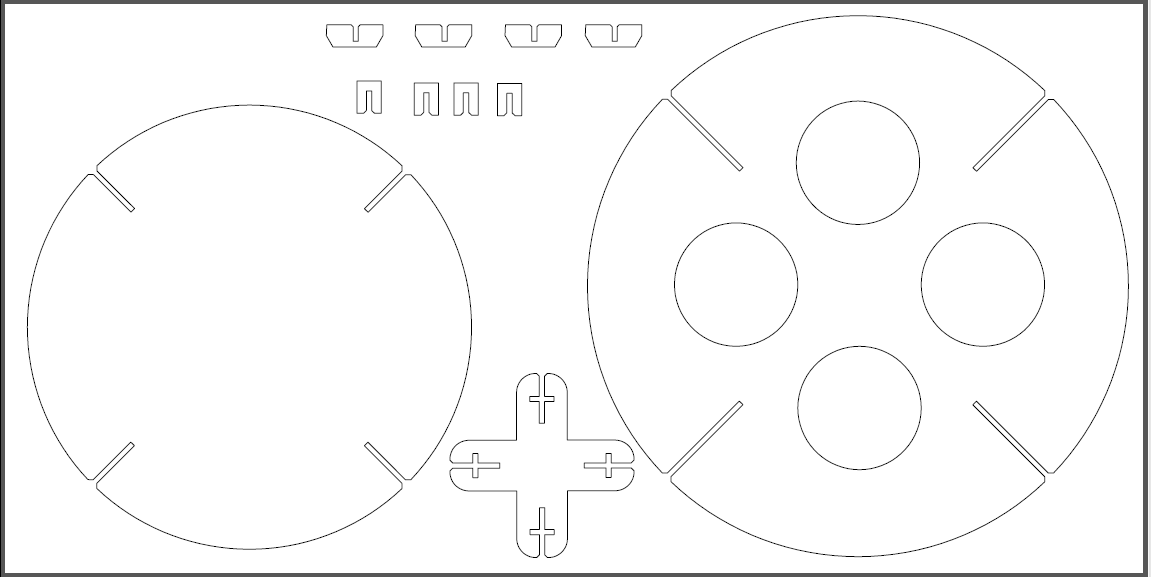

Week 3 - Snap Fit Kit
Kerf - Experiment and Findings
The first step in creating a snap fit kit is to determine the kerf of the laser when cutting cardboard at a defined thickness.
Kerf is defined as "A slit made by cutting with a saw" - Oxford English Dictionary.
In this case the saw is actually a laser and it seems easier to think of kerf as the waste in material when cut down a single line. To find the kerf of the laser when using cardboard (measured as 2.68mm using digital calipers) I created a test cut in Inkscape of a 20mm square and cut the square out in different locations on the bed.
I used manual focus when cutting to ensure I got an accurate focal length - as cardboard can be easily compressed it is not right to use auto-focus.
I did find a small difference between the kerf in different locations on the laser. Averagely the kerf was always more in the y-axis than in the x although the difference was down to 0.08mm. A possible reason for part of the error was the bend in the cardboard which causes the laser to be out of focus at certain points and thus burn with a wider beam. However this does not explain the difference between x and y axis cuts I will need to give that some thought (machine error?).
After measuring the resulting cutout squares and the holes that were made at each location I averaged the difference to be 0.5mm between the width of the resultant square and the slot. This means as there are 2 cut lines taht affect the width that the both have a kerf of 0.25mm. From the measurements of the reultant square and slot made I understand kerf to affect both sides of the cut line equally and therefore 0.125mm of material are lost form each side of the cut line. This can be shown in the diagram below.
The joints that I found to work best used the kerf value found and a small (4mm) chamfer on each edge to help with aligning the joints (see below).
Snap-fit Kit Design - Beer Bottle Carry Case
To keep the theme going of my final project proposal I will design a beer bottle carry case from snap-fit cardboard. Although this is not strictly multi-use as the brief asked for you are able to carry many different beers in the case and with the waste cardboard and some locking pins I will aim to create drink coasters that can be connected in different ways (using connections/locking pins) to cover a table.
To ensure all parts work together I will model the different elements in a Solidworks assembly. I was tempted to create a solid shape and use Autodesk 123D make to then create the cardboard snap-fit kit but I felt that was a small cheat really and doesn't give me the control over each joint that I want.
See the initial design below.
Render
Final Design
After a few additions to my design in Solidworks I was ready to transfer my design files to the laser cutter. To do this I saved each seperate part drawing in solidworks at 1:1 scale as a PDF to be opened in Inkscape. I then used Inkscape to layout my parts on the laser bed and ensured the line weight was set to 0.01mm. My design spread over 3 sheets as shown below.

The cardboard was cut on the laser using manual focus with settings SPEED: 40 POWER:90 FREQUENCY: 500 and here is the result.
Top - locking-pin system
Underside - Feet
Findings/Conclusion
My beer bottle holder in the shape of a barrel was overall a success for the snap fit assignment. I did notice that even after the kerf testing, the joints could have been tighter. This is likely due to a number of areas that can bring error into the calculation such as : consistancy of cardboard thickness, how flat the cardboard is that gets laser cut (beam width and kerf directly affected) and deformation of the material during assembly.
All in all the cardboard held together well and proved the design could work, and using another material with better strength such as birch plywood should prove to be a success. Although you can pick up four bottles of beer with the cardboard version it doesn't feel stable enough in the hand and this would be much improved by using a stiffer stronger material.
Downloadable Files
Laser Cutter pdf - page 1
Laser Cutter pdf - page 2
Laser Cutter pdf - page 3